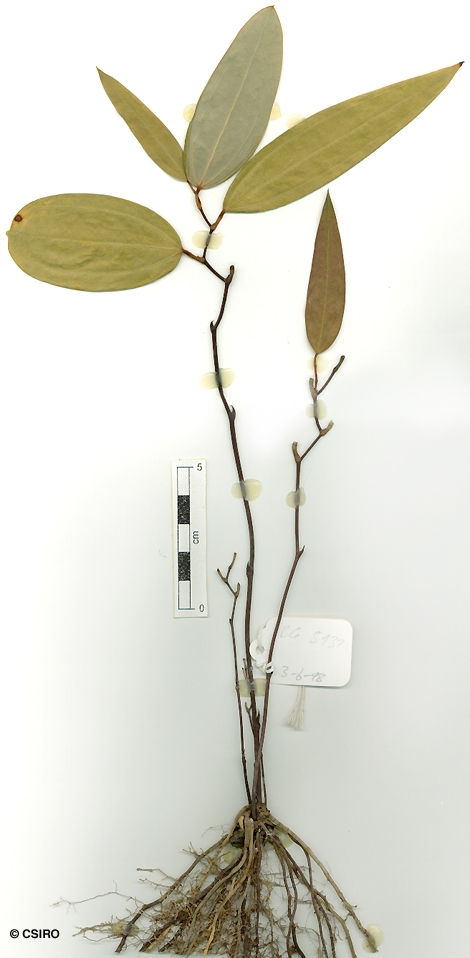Australian Tropical Rainforest Plants - Online edition
Smilax glyciphylla Sm.





Smith, J.E. (1790) Journal of a Voyage to New South Wales : 230. Type: New South Wales, Port Jackson, J. White, holo: ?.
Sweet Tea; Sarsaparilla, Native; Native Sarsaparilla; Sarsaparilla, Smooth; Sarsaparilla, Sweet; Sweet Sarsaparilla; Smooth Sarsaparilla
A slender vine not exceeding a stem diameter of 2 cm.
Male flowers: Flowers borne in umbels or panicles of umbels. Pedicels about 12-15 mm long. Sepals ovate, about 2.5 x 3 mm. Petals oblong, about 2.5-3 x 1 mm. Stamens six, anthers about 1.2 x 0.6 mm, +/- sessile. Female flowers: Pedicels about 6-8 mm long. Sepals ovate, about 2 x 1 mm. Petals oblong, about 2 x 0.8 mm. Staminodes linear, about 1-1.5 mm long. Ovary +/- globose, about 1 mm diam. Style absent. Stigma three-armed. Ovules one per locule.
Usually 1 or 2 cataphylls produced just outside the seed coat and 1 or 2 more further up the stem before the first true leaf. First true leaf ovate to lanceolate, about 3.5-5 x 1-1.5 cm, apex acute to acuminate and mucronate, base obtuse, petiole about 5-6 mm long, expanded at the base to form two wings which embrace the stem. At the tenth leaf stage: stems clustered, several stems arising from the one rhizome, leaf blades lanceolate to narrowly lanceolate, about 10 x 2.5 cm, apex acuminate, base cuneate, petiole about 6-7 mm long, base expanded into two wings which embrace the stem. Leaf blades usually three-veined, underside glaucous, midrib raised on the upper surface. Seed germination time 287 days.
This species was one of the earliest medicinal plants to be used in the colony, and its value as a tonic and a scurvy preventative was recorded in 1790 by the Surgeon-General, John White. The leaves are used, and the tea made from them gives a drink which is sweet and bitter at the same time. In the colonial times the drink was sold under the name of sarsaparilla. Cribb (1981).





